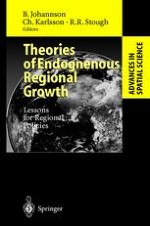2001 | Buch
Theories of Endogenous Regional Growth
Lessons for Regional Policies
herausgegeben von: Prof. Dr. Börje Johansson, Prof. Dr. Charlie Karlsson, Prof. Dr. Roger R. Stough
Verlag: Springer Berlin Heidelberg
Buchreihe : Advances in Spatial Science
Enthalten in: Professional Book Archive
